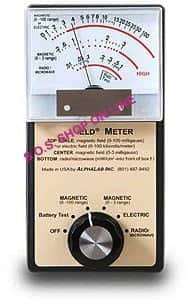General info
A knob on the front has six positions: OFF, BATTERY TEST, two MAGNETIC field sensitivities (0.5-100 milligauss at 60 Hz, and 0.2-3 milligauss at 60 Hz, the second sensitivity to measure weak fields more accurately), ELECTRIC field and RADIO/MICROWAVE power density. The meter face is analog (needle type). A needle reading of one-third of full scale corresponds to either 3 milligauss (or 0.6 milligauss) @ 60 Hz, 3 kilovolts/meter @ 60 Hz, or 0.04 mW/cm2 respectively in the magnetic, electric, and radio/microwave field settings. Average magnetic field strength in North American homes and offices is 1-3 milligauss, so the meter is labeled "HIGH" above these levels.
MAGNETIC FIELD DETECTION
In most homes or offices, some areas are "hot" spots with readings in the HIGH range. Most often, this is caused by magnetic fields, which come largely from unpaired internal wiring. (Contrary to popular belief, power transmission lines and transformers do not generally contribute as much magnetic field as does internal wiring.) Other magnetic sources include video displays, motorized clocks and other equipment, electric blankets and heaters, fluorescent lights and light dimmers, and the transformers that are inside consumer devices. Much of the total field strength is from frequencies that are harmonics or multiples of 60 Hz (120 Hz, 180 Hz, etc.) and 17,000 Hz of video displays. Cars (especially near the front floorboard of electronic ignition cars) and motorcycles have fairly strong fields that are at frequencies higher than 60 Hz. Magnetic field is difficult to shield, but sheet steel is somewhat effective.
ELECTRIC FIELD DETECTION
A few areas in most homes read HIGH in the electric field setting. These include areas near improperly grounded equipment, the front of video screens, and fluorescent lights. Most of these fields can be easily shielded using a grounded metal screen or foil; VDT screens of this type are readily available. You can greatly reduce the strength of an electric field just by placing your hand in front of the source. This effect can be seen using a TriField meter.
MICROWAVE DETECTION
Occasionally, certain areas read HIGH in the radio/microwave setting. These include door seals around microwave ovens, and cellular phones (but not regular radio phones, which are very low-power). Radio/microwaves can be shielded in the same way as electric fields, although the lower frequency radio waves are not shielded by your hand as easily as microwaves are. (Metal screens will shield both.) In the United States, radars and FM transmitters can legally expose residents to moderately high power levels (as high as 10 mW/cm2 briefly or .57 mW/cm2 near cellular towers), but such exposure is not common.


